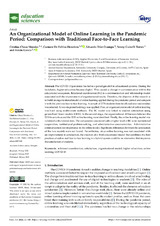An Organizational Model of Online Learning in the Pandemic Period: Comparison with Traditional Face-to-Face Learning
Autor
Checa-Morales, Cristina
Pablos-Heredero, Carmen de
Díaz Ocampo, Eduardo
Torres, Yenny Guiselli
García, Antón
Editor
MDPIFecha
2022Materia
Relational coordinationSatisfaction
Organizational model
Higher education
Online learning
COVID-19
METS:
Mostrar el registro METSPREMIS:
Mostrar el registro PREMISMetadatos
Mostrar el registro completo del ítemResumen
The COVID-19 pandemic has led to a paradigm shift in educational systems. During the lockdown, higher education became digital. This caused a change in communication within the educational ecosystem. Relational coordination (RC) is a communication and relationship model associated with the improvement of organizational results. Therefore, the objective of this research is to build an organizational model of online learning applied during the pandemic period and compare it with the previous face-to-face learning. A sample of 2774 students from two Ecuadorian universities was selected. A two-stage methodology was applied: First, an organizational model of online learning was built using multivariate methods. The RC model was linked to student satisfaction using generalized linear models (GLM). In the second stage, the organizational differences between the 2018 face-to-face and the 2020 online learning were identified. Finally, the online learning model was validated with external data. The components associated with a higher level of RC were institutional cooperation, institutional problem-solving, and administrative communication. Administrative communication lost importance in the online model. Significant differences between the satisfaction of the two models were not found. Nevertheless, since online learning was not associated with an improvement in satisfaction, the creation of a third educational model that combines the best practices of online and face-to-face learning in a hybrid system could be an alternative that improves the satisfaction of students.

